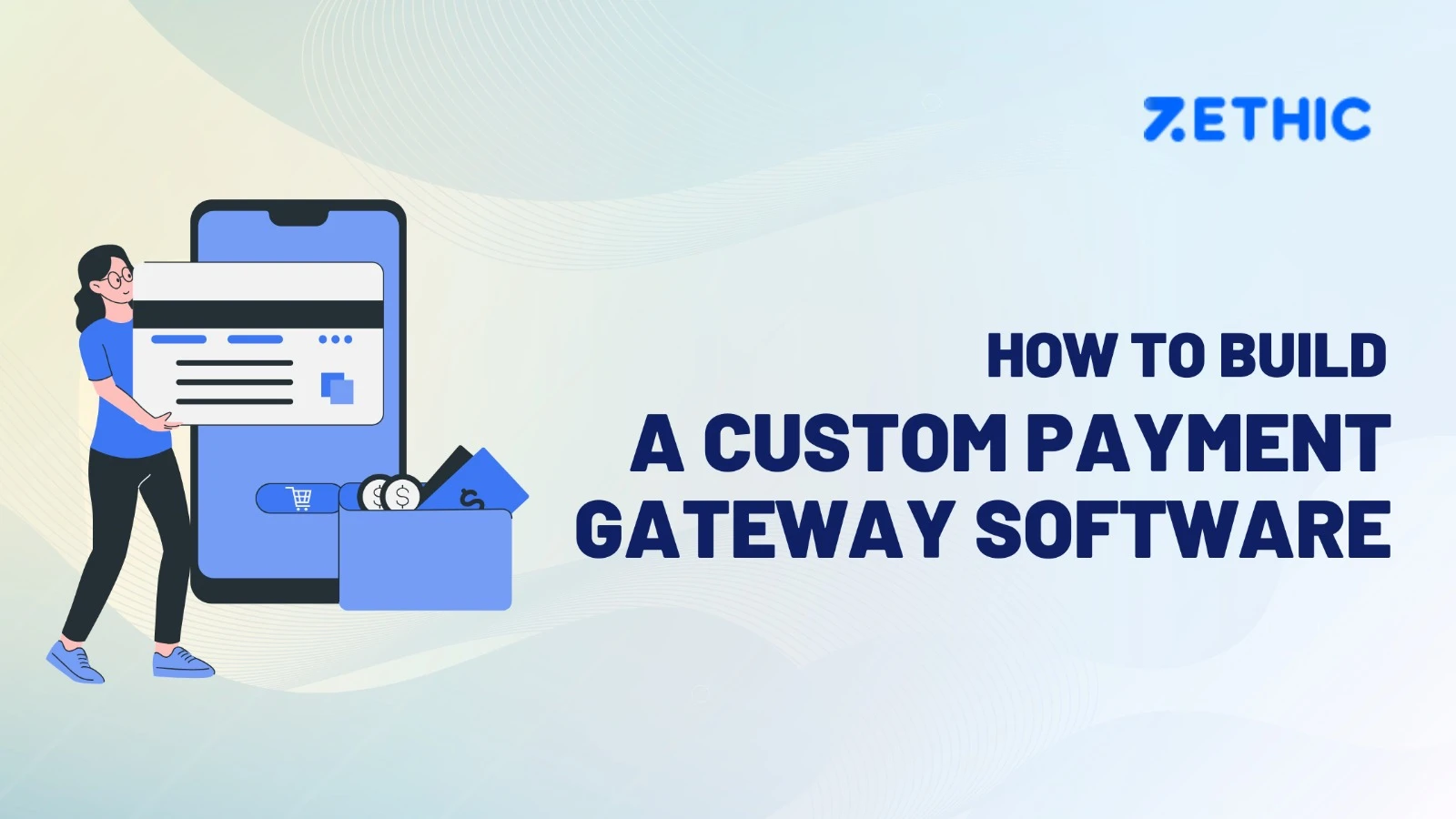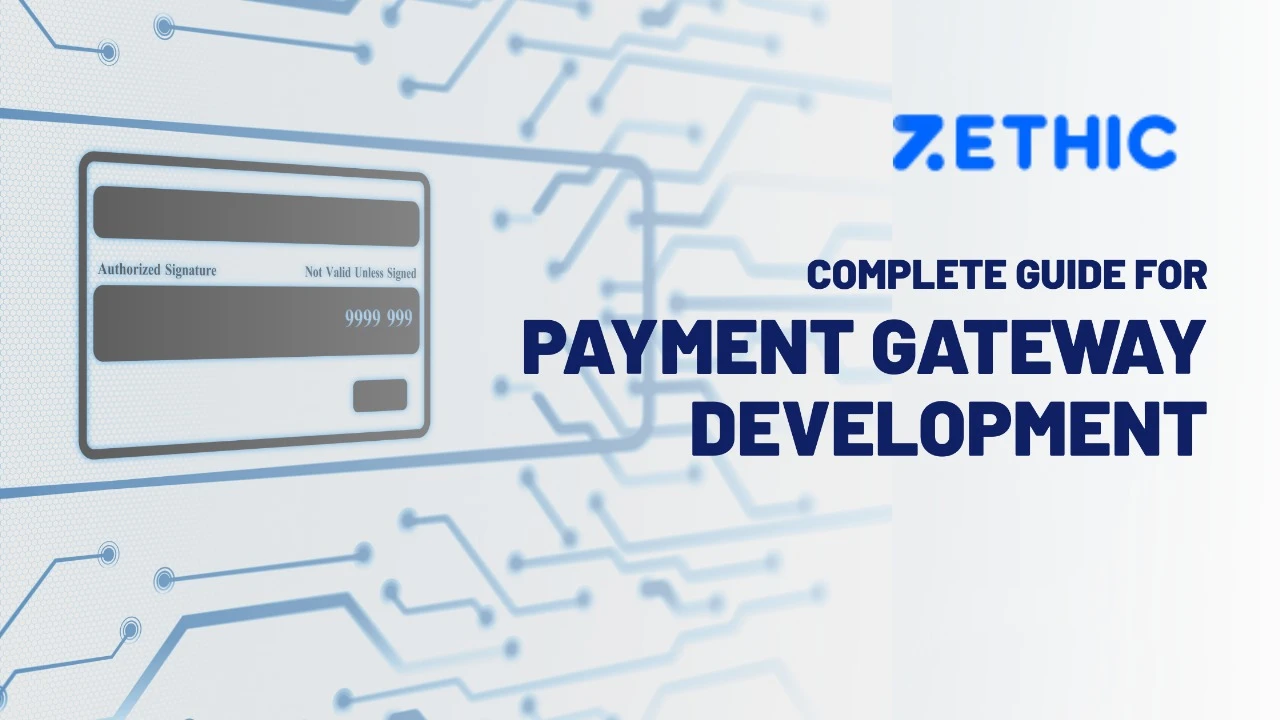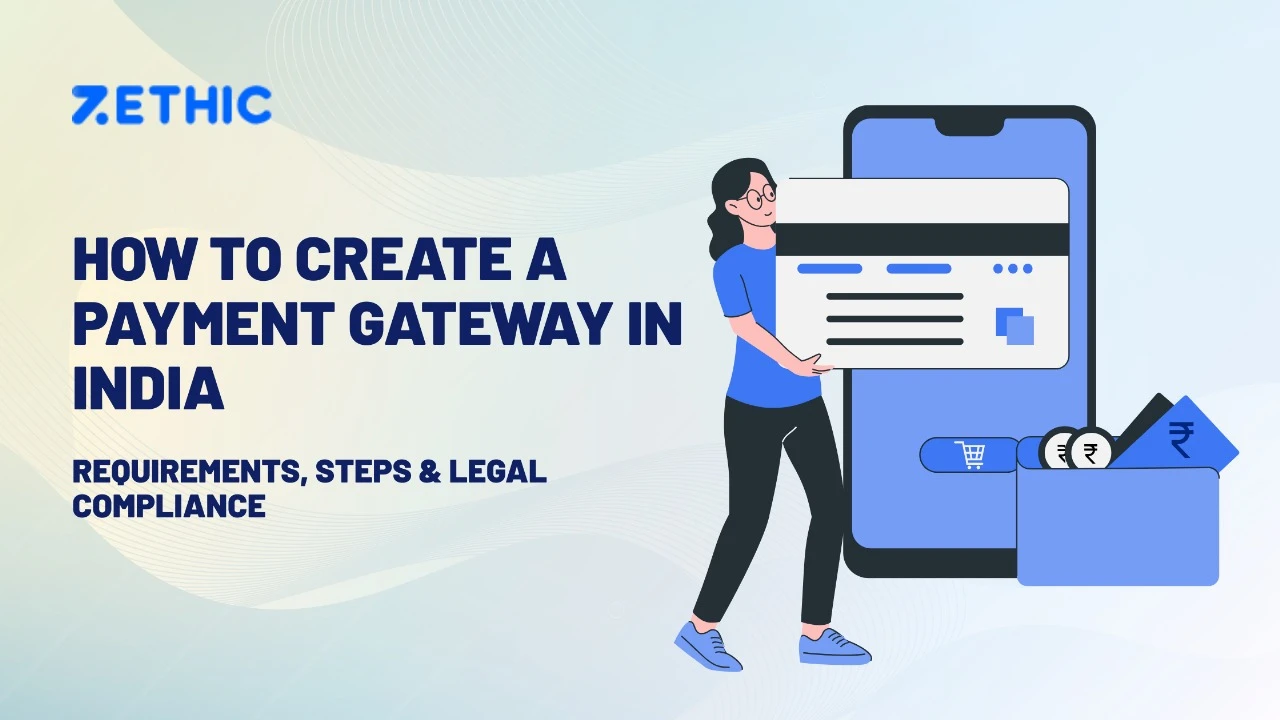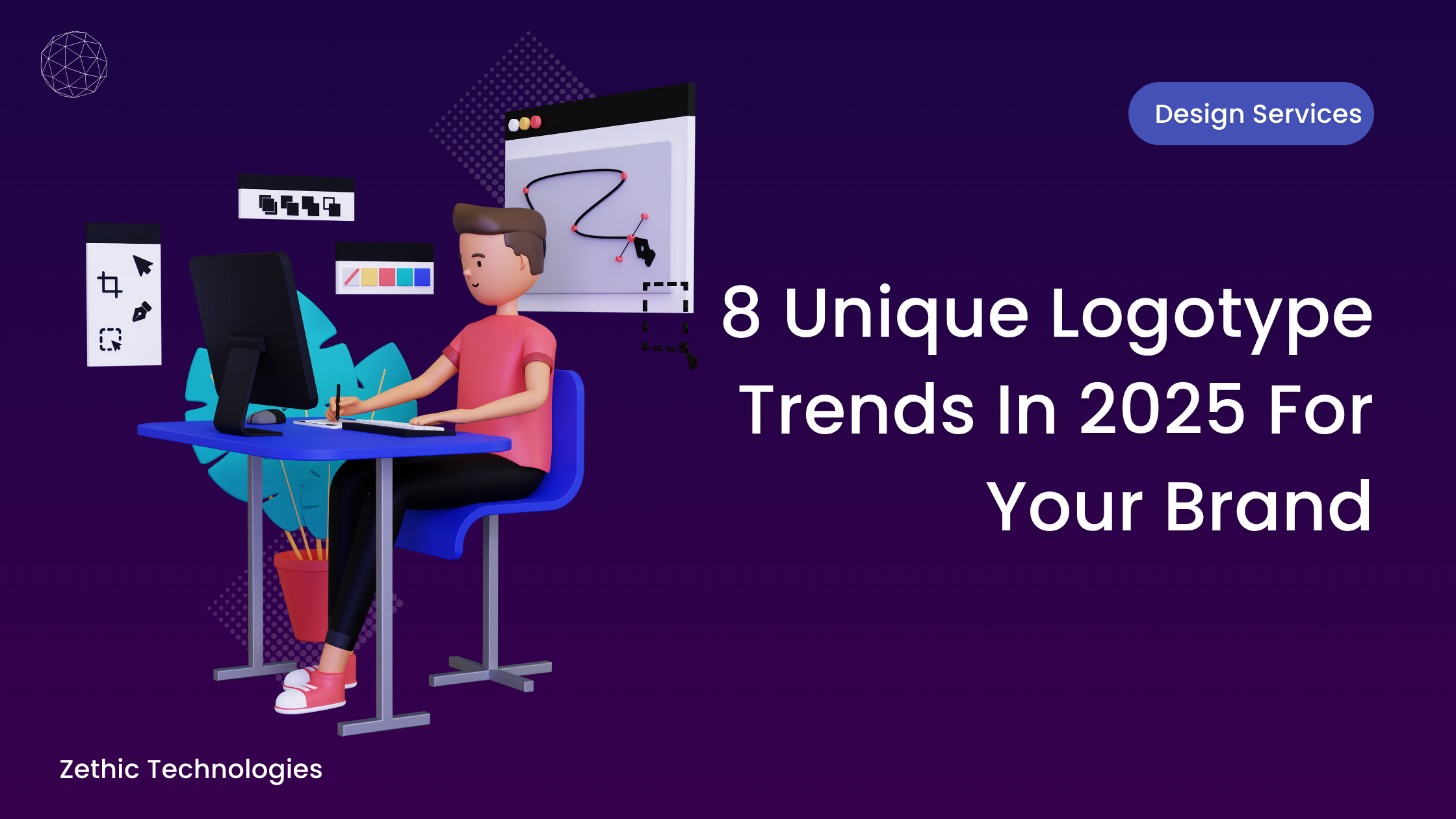The global fintech market is booming expected to hit $492 billion by 2028 with a CAGR of 16.8%. At the heart of this growth is the rising demand for custom payment gateway software, empowering businesses to take control of their transactions, lower costs, and deliver seamless digital experiences.
From eCommerce platforms to P2P payments, companies are shifting from generic solutions like Stripe or Razorpay to custom-built gateways tailored to their needs. With India’s UPI processing over 10 billion transactions monthly and global digital payments projected to exceed $14.78 trillion by 2027, the opportunity is massive.
But building a gateway is no simple task. It requires deep expertise in payment gateway software development, API integration, security (like PCI-DSS), and compliance with financial standards.
In this blog, we’ll guide you step-by-step through designing, developing, and deploying your own custom payment gateway backed by real-world insights from Zethic’s fintech engineering team.
Why Build a Custom Payment Gateway in 2025?
The global fintech market is undergoing rapid expansion: from USD 340.1 billion in 2024 it is projected to reach USD 394.9 billion in 2025, scaling to USD 1.13 trillion by 2032, reflecting a CAGR of ~16.2%. Meanwhile, unified growth in digital payments expected to hit USD 14.8 trillion by 2027 at ~11.8% CAGR illustrates the accelerating demand for in-house payment infrastructure.
In India specifically, digital payments surged 34.8% in FY 2024–25, with UPI alone accounting for over 84% of retail digital transactions (185.8 billion invoices valued at ₹261 lakh crore). The RBI’s Digital Payments Index (DPI) rose to 493.22 by March 2025, a 10.7% YoY increase, reflecting rapid adoption and infrastructure expansion.
Building a custom payment gateway gives enterprise-level control over routing, fees, security, and integrations minimizing reliance on Stripe or PayPal’s fixed-logic platforms. This is especially valuable for high-volume, cross-border, or enterprise clients where per transaction margins matter, regulatory localisation like UPI engines are needed, and brand-specific flows improve loyalty.
Benefits of Custom Payment Gateway Software
- Full Control & Compliance
Design payment logic, merchant onboarding flows, transaction routing (e.g. UPI, Visa, global APMs), and duty-cycle settlements to suit business logic and regional laws (e.g. RBI/UPI regulations). - Lower Long-Term Costs
Instead of 2.9% + ₹2 or ~30 cents per transaction, direct acquirer integrations and optimized routing can reduce fees at scale — ideal for enterprise merchants and SaaS providers. - Enhanced Security Architecture
Full ownership over PCI-DSS scoping, tokenization (HSM/in-house vault), idempotency handling, retry logic, and fraud engines. Achieve audit readiness without vendor lock-in. - Seamless Tech Ecosystem Integration
Embed the gateway into CRM/ERP, loyalty platforms, fraud workflows, CRM chatbots reducing user friction and manual reconciliation. - Scalability & Regional Flexibility
Support multi-currency, regional rails (e.g. UPI, IMPS), cross-border payment routing, sub‑merchant boarding, split payments, or wallet systems custom built to your UX and API needs. - Revenue Opportunities Beyond cost savings, offer analytics-as-a-service or gateway-as-a-service models, charging subscription fees or tiered processing plans.
10-Step Guide to Build Your Custom Gateway
3.1 Understanding the Core Architecture
Identify key components of your custom payment gateway architecture:
- Merchant onboarding / KYC flows
- Checkout UX / SDKs: hosted, redirection (PCI-SaaS), or inline (jet-enabled REST APIs)
- Routing & connector engine: adapters to banks, UPI, card switches
- Processing backend: tokenization, failure management, idempotency, webhook orchestration
- Dashboard & Reconciliation UI: real-time settlement, disputes, refund flows
- Analytics & Logs: minimal latency pipelines, transaction history, fraud scoring
This architecture is critical to both payment gateway software development and payment gateway API development workflows.
3.2 Market & Merchant Research
- Market segmentation: eCommerce, logistics SaaS, embedded finance, subscriptions
- Competitor audit: Stripe, Razorpay, Paytm assess fee models, API ease, localisation gaps
- Merchant interviews: identify pain from refunds, delayed settlements, cross-border challenges, or manual reconciliation overheads
Use these insights to clearly define your unique value proposition and API differentiation points.
3.3 API & System Design
- API-First Strategy: RESTful JSON endpoints (with optional GraphQL support) for all operations — payments, refunds, merchant onboarding, reports. Define contracts using OpenAPI and provide Postman collections and client SDKs (JavaScript / Flutter, etc.)
- Microservice & Event-Driven Architecture: separate modules for routing, tokenization, fraud, reconciliation; use Apache Kafka or RabbitMQ for high-throughput events, asynchronous retry paths
- Modularity: implement connector adapters (e.g. for UPI, IMPS, Visa/Mastercard) to allow easy rail addition or replacement
- UI Flows: support both white-label web checkout and in-app SDK. Prioritize smooth flow with hosted pages and error resilience via webhooks and retry logic
3.4 Tech Stack & Infrastructure
- Backend Languages: Go or Java (Spring Boot/Camel) for high-throughput rails; Node.js/TypeScript preferred by JS-native teams.
- Databases: SQL (PostgreSQL/MySQL) for transactional fidelity; NoSQL (MongoDB/Clickhouse) for logs and analytics
- Security Layers: HSM-managed PCI-DSS vaults, encryption at rest/transit, segregated key store, tokenization middleware
- API Tools: OpenAPI v3, automated schema validation, mock servers for partner onboarding
- DevOps: Deploy on AWS/Azure/GCP using Kubernetes/EKS/AKS or Terraform-managed Lambdas. Use autoscaling, retries, circuit-breakers for fault tolerance
3.5 Building Processing & Connector Modules
- Acquirer connectors: build configurable pluggable modules for each acquirer or rail. For UPI, mirror NPCI’s UPI API (IMPS + UPI overlay), for cards integrate ISO 8583 or REST APIs from acquiring banks.
- Tokenization Layer: map card details into tokens that your system uses internally; ensure compliance with PCI SAQ A or SAQ D based on scope
- Payment orchestration: implement routing logic — e.g. if UPI fails, fallback to IMPS or scheduled retry. Support refund paths, partial settlement updates.
- Webhooks & Notifications: expose endpoints for merchant callback URLs; send notifications asynchronously. Secure endpoints with time-stamped digital signatures and replay protection.
- Idempotency & Fault Handling: ensure that repeating a charge event does not double bill. Use idempotency keys and FIFO processing to prevent duplication.
3.6 Bank & Rail Integrations
- Regulatory Acquirer Partnerships: In India, register as PPI or aggregator per RBI requirements; connect to NPCI sandbox environments. Globally, connect directly to VISA/Mastercard or via payment switches.
- Sandbox & Certification: Use NPCI certification path for UPI, Visa/Mastercard sandbox for cards; perform settlement reconciliations testing.
- Settlement Flows: handle nodes like T+1 or T+2 cycles, ambiguous settlement states, chargeback handling. Maintain nodal account ledger.
- Reconciliation Engine: auto-match incoming settlement files with internal transactions; highlight mismatches for finance teams.
3.7 Compliance, Licensing & Security
- PCI‑DSS Compliance: Identify scope (SAQ-A vs SAQ-D). Implement the 12 control groups: firewall, encryption, access control, logging, vulnerability scanning, pen-testing.
- RBI Licensing (India): aggregator/KYC/Government license requirements; real estate-specific UPI merchant categories; IMPS/UPI switching scans
- Data Privacy Laws: GDPR, PDPA, CCPA — handle encrypted PII (names, phone numbers), obtain consent templates, support deletion and user portability.
- Fraud Mitigation: integrate 3-D Secure, risk scoring with ML or rule engine (IP velocity, device fingerprinting, geolocation), blacklists, time-based OTP throttling.
- Pen Testing & Certifications: partner with third-party security audit firms for annual testing and risk scoring
3.8 Testing Strategy
- Unit and Contract Testing: ensure all API endpoints and internal modules catch edge cases—simulate all ard codes and failure responses.
- Integration Testing: connect with sandbox environments: NPCI’s test harness, VISA/Mastercard simulator, UAT merchants to simulate refunds, reversals, rollbacks.
- Performance & Stress Testing: simulate peak loads like 1000 TPS to test queue back-pressure; introduce network delays, simulate acquirer downtimes.
- UAT with Pilot Merchants: conduct end-to-end testing (checkout → webhook → settlement → dashboard → refund/dispute). Validate flows with real merchant UX.
- Fraud Scenarios: simulate chargebacks, duplicate tokens, synthetic identity payments, and verify detection and reversal workflows
3.9 Deployment & Production Launch
- Deployment Strategy: use blue-green or canary deployments to avoid downtime. Automatically roll back on latency or error spike.
- Security & Domain Setup: acquire TLS certificates, wildcard domains for hosted checkout (e.g. checkout.yourdomain.com). Use HSTS, secure cookies, CSP headers.
- Monitoring & Observability: integrate Prometheus, Grafana, ELK or Datadog. Set alerts for latency, failure spikes, retry storms, customer SLA breaches.
- Pilot Rollout Plan: onboard 1–3 pilot merchant accounts, collect real metrics, scale incrementally across verticals and geographies
3.10 Maintenance & Iteration
- Security Maintenance: schedule quarterly vulnerability scans and patch dependencies. Maintain pen test cycles.
- Performance Monitoring: monitor failure rate, latency percentiles, settlement completion ratios, API traffic volumes.
- API Versioning & Backward Compatibility: adopt semantic versioning and migration guides; provide fall-back support for older endpoints.
- Merchant Support Process: integrate a ticketing/KYC platform for customer inquiries, dispute handling workflow, SLA tracking.
- Continuous Feedback Loop: track cancellations, refusals, latency exceptions; feed this into system improvements and new feature roadmaps
4 . Estimated Cost & Timeline
- MVP Timeline: A lean version of your gateway—covering API endpoints, connector to 1 rail (e.g. UPI), basic dashboard, sandbox sign‑offs—typically takes 6–9 months.
- End‑to‑end compliant system: adding multiple rails, full dashboards, compliance certification (PCI/RBI/3-D Secure), and multi-region deployment may stretch to 12–18 months
- Cost Range (based on industry surveys):
- Core system: USD 100,000–500,000 depending on team size, complexity, and audit scope
- Full compliance stack with HSM integrations, orchestration engines, UI dashboards may exceed USD 500K–1.2 M In comparison, ongoing SaaS gateways charge per‑transaction fees; at volumes above $100M/month, building in-house often pays back within 18–24 months.
Market Trends & Fintech Growth Narrative
| Region | Metric | Value |
|---|---|---|
| Global | Fintech Market (2025–2032) | USD 394.9 bn → USD 1.13 tn (16.2% CAGR) |
| Global | Digital Payments by 2027 | USD 14.78 tn (11.8% CAGR) |
| India | DPI (March 2025 YoY) | 493.22 vs 445.5 in March 2024 (+10.7%) |
| India | FY 2024–25 UPI Share | 185.8 bn trxn; ₹261 lakh crore (~84% share) |
| India | UPI July 2025 Record | 1,947 crore trxn; ₹25.08 lakh crore (22% YoY) |
These numbers reinforce the logic: when transaction volume grows into hundreds of millions/month with premiums on custom rails, the ROI for owning your gateway becomes compelling.
Why Zethic is India’s Trusted Partner for Fintech Software Development
Based in Bangalore, Zethic has delivered over 60 enterprise-level fintech projects, helping global clients embed smooth, secure payment flows. We specialize in payment gateway software development, from payment gateway API development to regulatory support. Learn more about our services at Fintech Software Development, or explore our Web & Mobile App, AI-Powered Fraud Detection, and Blockchain & dApps offerings. This blog positions Zethic as a Bangalore-based fintech enterprise partner with global delivery capabilities.
Conclusion
In 2025, fintech transforms at scale global markets topping USD 1 trillion by 2032 and digital payments becoming core to commerce across Asia-Pacific. Building a custom payment gateway is no longer a niche play it’s a strategic requirement for enterprises that want to future-proof payments, reduce dependency on third-party fees, and own customer experience.
If you’re ready to architect scalable, compliant custom payment gateway software, embedded with powerful APIs and regional rails, Zethic is your trusted Bangalore-based fintech partner.

People Also Ask
What is payment gateway API development?
It involves designing secure REST/GraphQL endpoints for transaction capture, merchant onboarding, authentication, refunds, and webhooks. Includes SDKs and API contracts to facilitate integration with eCommerce platforms, wallets, or checkout UIs.
How much does it cost to build a custom payment gateway software?
It involves designing secure REST/GraphQL endpoints for transaction capture, merchant onboarding, authentication, refunds, and webhooks. Includes SDKs and API contracts to facilitate integration with eCommerce platforms, wallets, or checkout UIs.
How much does it cost to build a custom payment gateway software?
A scaled build usually costs between USD 100K–500K, over 6–18 months, depending on compliance levels and number of rails supported. High‑volume enterprises can realise lower long-term fees and greater control versus third-party SaaS.
Should you build or buy a payment gateway?
Build if you need full technical control, multi‑rail support, localization (e.g. UPI, IMPS), and cost efficiency at scale. Buy if time‑to‑market is critical and you accept fixed pricing logic. Consider scalability, international capabilities, and audit overhead when deciding.
How long does it take to develop a custom payment gateway?
An MVP can be developed in 6–9 months. A fully compliant, multi-rail version aimed at enterprise markets typically takes 12–18 months, especially including security certifications and user acceptance testing.






